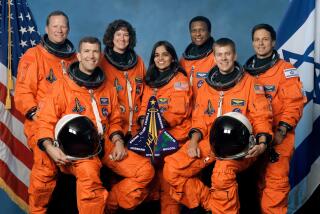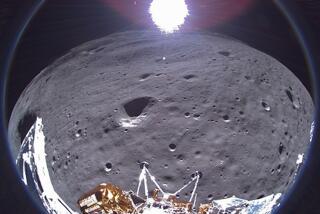Discovery Leaves Earth and Frustration Behind : Space: The shuttle launches a spacecraft to explore the sun. The blast into orbit ends five months of embarrassing NASA glitches.
KENNEDY SPACE CENTER, Fla. — Five months of frustration came to a dramatic end here Saturday when the space shuttle Discovery blasted into orbit on an international mission to explore the polar regions of the sun.
“There’s a lot of smiling faces up here,” Discovery commander Richard N. Richards, 44, told Mission Control soon after the launch at 4:47 a.m. PDT.
There also were a few smiles on the ground.
“It’s good to be back in the air again,” beamed launch director Robert Sieck after the nearly perfect launch ended the longest down spell that the National Aeronautics and Space Administration has had since the Challenger explosion.
Discovery successfully completed its primary mission six hours into the flight when it sent an unmanned robotic probe on a 2-billion-mile journey that will culminate in an unprecedented reconnaissance of the south and north poles of the sun, beginning in four years.
The launch of Discovery was immensely important to NASA, which has been living under a dark cloud for months. Officials desperately wanted to send the much-delayed Ulysses spacecraft on its way and keep their European partners happy.
The European-built Ulysses is all that is left of what was to have been a two-spacecraft expedition. The second craft was to have been supplied by NASA, but the project was scaled back years ago because of budgetary problems.
The failure by the United States to provide the second spacecraft deprives the mission of the opportunity to study both poles of the sun simultaneously, and it leaves the project without a camera because that was to have been on the U.S. craft.
The launch of Ulysses was seven years late, due mainly to the Challenger explosion in 1986, and the delays had become a sore spot for European scientists, who also are partners in the planned space station Freedom.
NASA did not want to see that relationship erode any further, and the Ulysses mission was given its highest priority.
Shortly after the Discovery lifted off on a clear, warm morning Saturday, Sieck described the attitude in the launch control room as “one of euphoria and relief.”
“It’s a great day,” added Edward Smith, Ulysses project scientist at the Jet Propulsion Laboratory, which is managing the U.S. participation in the Ulysses program.
Six hours after the launch, the solar probe was released from Discovery’s payload bay.
“Ulysses is on its way,” Richards radioed to Mission Control.
A short time later, Ulysses fired the first of three upper stage rockets and set a speed record as it raced off on a long, twisted road to the sun.
It was necessary for the craft to speed away at 34,130 m.p.h, a record “escape velocity,” in order to go directly to Jupiter. Ulysses will use that planet’s gravity to accelerate into an orbit that will carry it over the sun’s poles.
Since the Earth orbits around the sun’s equator, scientists have been unable to study the polar regions, and thus have had an incomplete picture of the sun. As NASA chief scientist Lennard Fisk observed, someone standing on the Earth’s Equator would have a difficult time figuring out what it is like at the poles.
“The only way to understand it is to go there and look,” Fisk said.
It is not possible for humans to do that on the sun, so Ulysses will use 11 different experiments to study the sun as the craft passes over the south pole in 1994 and the north pole in 1995.
Of particular interest will be the impact of the polar regions on such things as sunspots and solar flares and the 1-million-m.p.h. solar winds. In addition, scientists hope what they learn from the sun will tell them more about trillions of other stars.
“Ulysses will be a cosmic detective,” said Peter Wenzel, chief project scientist for the European Space Agency.
The robotic spacecraft, cornerstone of a $750-million program, will seek information on the sun’s magnetic field, which plays a major role in forming the solar winds that are responsible for such things as blowing dust off a comet and forming a tail. Other areas of interest include the chemical composition and temperature of charged particles that are being blown off the sun by the solar wind, and the nature of “cosmic dust” streaming into the sun from space.
By the time Ulysses’ mission is over, scientists expect to have gathered enough data from the spacecraft to “rewrite the textbooks,” Fisk said.
A successful launch was just what NASA needed Saturday, with two of its shuttles grounded because of fuel leaks and growing questions over the quality of its craftsmanship. So NASA called on Discovery for a triumph, just as it has in the past.
It was Discovery that returned the nation to space flight after the Challenger explosion, and it was Discovery that flew last April, launching the Hubble Space Telescope. But the telescope turned out to be flawed, and in recent months NASA seems to have stumbled repeatedly.
The space agency’s problems were underscored two days before Discovery’s launch when officials here disclosed that the shuttle Atlantis, already grounded because of a fuel leak, had been damaged by a steel beam that was inadvertently left inside the shuttle’s engine compartment. When Atlantis was hoisted into a vertical position to prepare it for next month’s Defense Department launch, the 70-pound beam, used to support scaffolding for workers, plunged down through the compartment, denting fuel lines as it fell.
The extent of the damage was not thought to be significant, but it gave NASA’s reputation another jolt. The nine-foot-long beam is painted bright yellow. Two supervisors had signed off on a check sheet certifying that the beam and other materials used by workers inside the compartment had been removed.
NASA officials said they had no explanation for how the beam could have been overlooked.
With their primary objective already behind them, the five crewmen aboard Discovery turned their attention later Saturday to a number of experiments they plan to carry out during the unusually short mission. The shuttle is scheduled to land at Edwards Air Force Base in Southern California on Wednesday at 6:54 a.m.
The other members of the crew are Robert D. Cabana, 41, the pilot, and mission specialists William M. Shepherd, 41; Bruce E. Melnick, 40, and Thomas D. Akers, 39.
Dye recently was on assignment in California.
More to Read
Sign up for Essential California
The most important California stories and recommendations in your inbox every morning.
You may occasionally receive promotional content from the Los Angeles Times.










